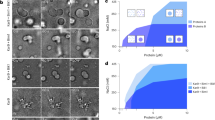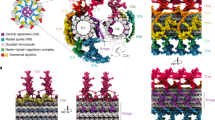Abstract
A microtubule network on the basal cortex of polarized epithelial cells consists of non-centrosomal microtubules of mixed polarity. Here, we investigate the proteins that are involved in organizing this network, and we show that end-binding protein 1 (EB1), adenomatous polyposis coli protein (APC) and p150Glued — although considered to be microtubule plus-end-binding proteins — are localized along the entire length of microtubules within the network, and at T-junctions between microtubules. The network shows microtubule behaviours that arise from physical interactions between microtubules, including microtubule plus-end stabilization on the sides of other microtubules, and sliding of microtubule ends along other microtubules. APC also localizes to the basal cortex. Microtubules grew over and paused at APC puncta; an in vitro reconstituted microtubule network overlaid APC puncta; and microtubule network reconstitution was inhibited by function-blocking APC antibodies. Thus, APC is a component of a cortical template that guides microtubule network formation.
This is a preview of subscription content, access via your institution
Access options
Subscribe to this journal
Receive 12 print issues and online access
$209.00 per year
only $17.42 per issue
Buy this article
- Purchase on Springer Link
- Instant access to full article PDF
Prices may be subject to local taxes which are calculated during checkout








Similar content being viewed by others
Accession codes
References
Mimori-Kiyosue, Y. & Tsukita, S. “Search-and-capture” of microtubules through plus-end-binding proteins (+TIPs). J. Biochem. (Tokyo) 134, 321–326 (2003).
Vaughan, K. T. Surfing, regulating and capturing: are all microtubule-tip-tracking proteins created equal? Trends Cell Biol. 14, 491–496 (2004).
Gundersen, G. G., Gomes, E. R. & Wen, Y. Cortical control of microtubule stability and polarization. Curr. Opin. Cell Biol. 16, 106–112 (2004).
Brunner, D. & Nurse, P. CLIP170-like tip1p spatially organizes microtubular dynamics in fission yeast. Cell 102, 695–704 (2000).
Rogers, S. L., Rogers, G. C., Sharp, D. J. & Vale, R. D. Drosophila EB1 is important for proper assembly, dynamics, and positioning of the mitotic spindle. J. Cell Biol. 158, 873–884 (2002).
Komarova, Y. A., Akhmanova, A. S., Kojima, S., Galjart, N. & Borisy, G. G. Cytoplasmic linker proteins promote microtubule rescue in vivo. J. Cell Biol. 159, 589–599 (2002).
Fukata, M. et al. Rac1 and Cdc42 capture microtubules through IQGAP1 and CLIP-170. Cell 109, 873–885 (2002).
Wen, Y. et al. EB1 and APC bind to mDia to stabilize microtubules downstream of Rho and promote cell migration. Nature Cell Biol. 6, 820–830 (2004).
Mimori-Kiyosue, Y. et al. CLASP1 and CLASP2 bind to EB1 and regulate microtubule plus-end dynamics at the cell cortex. J. Cell Biol. 168, 141–153 (2005).
Mimori-Kiyosue, Y., Shiina, N. & Tsukita, S. The dynamic behavior of the APC-binding protein EB1 on the distal ends of microtubules. Curr. Biol. 10, 865–868 (2000).
Mimori-Kiyosue, Y., Shiina, N. & Tsukita, S. Adenomatous polyposis coli (APC) protein moves along microtubules and concentrates at their growing ends in epithelial cells. J. Cell Biol. 148, 505–518 (2000).
Watanabe, T. et al. Interaction with IQGAP1 links APC to Rac1, Cdc42, and actin filaments during cell polarization and migration. Dev. Cell 7, 871–883 (2004).
Barth, A. I., Siemers, K. A. & Nelson, W. J. Dissecting interactions between EB1, microtubules and APC in cortical clusters at the plasma membrane. J. Cell Sci. 115, 1583–1590 (2002).
Heuser, J. The production of 'cell cortices' for light and electron microscopy. Traffic 1, 545–552 (2000).
Drees, F., Reilein, A. & Nelson, W. J. Cell-adhesion assays: fabrication of an E-cadherin substratum and isolation of lateral and basal membrane patches. Methods Mol. Biol. 294, 303–320 (2004).
Allan, V. Protein phosphatase 1 regulates the cytoplasmic dynein-driven formation of endoplasmic reticulum networks in vitro. J. Cell Biol. 128, 879–891 (1995).
Paschal, B. M., Shpetner, H. S. & Vallee, R. B. MAP 1C is a microtubule-activated ATPase which translocates microtubules in vitro and has dynein-like properties. J. Cell Biol. 105, 1273–1282 (1987).
Schnapp, B. J. & Reese, T. S. Dynein is the motor for retrograde axonal transport of organelles. Proc. Natl Acad. Sci. USA 86, 1548–1552 (1989).
Schroer, T. A., Steuer, E. R. & Sheetz, M. P. Cytoplasmic dynein is a minus end-directed motor for membranous organelles. Cell 56, 937–946 (1989).
Nathke, I. S., Adams, C. L., Polakis, P., Sellin, J. H. & Nelson, W. J. The adenomatous polyposis coli tumor suppressor protein localizes to plasma membrane sites involved in active cell migration. J. Cell Biol. 134, 165–179 (1996).
Etienne-Manneville, S. & Hall, A. Cdc42 regulates GSK-3β and adenomatous polyposis coli to control cell polarity. Nature 421, 753–756 (2003).
Zhou, F. Q., Zhou, J., Dedhar, S., Wu, Y. H. & Snider, W. D. NGF-induced axon growth is mediated by localized inactivation of GSK-3β and functions of the microtubule plus end binding protein APC. Neuron 42, 897–912 (2004).
Rosin-Arbesfeld, R., Ihrke, G. & Bienz, M. Actin-dependent membrane association of the APC tumour suppressor in polarized mammalian epithelial cells. EMBO J. 20, 5929–5939 (2001).
Mogensen, M. M., Tucker, J. B., Mackie, J. B., Prescott, A. R. & Nathke, I. S. The adenomatous polyposis coli protein unambiguously localizes to microtubule plus ends and is involved in establishing parallel arrays of microtubule bundles in highly polarized epithelial cells. J. Cell Biol. 157, 1041–1048 (2002).
Munemitsu, S. et al. The APC gene product associates with microtubules in vivo and promotes their assembly in vitro. Cancer Res. 54, 3676–3681 (1994).
Askham, J. M., Moncur, P., Markham, A. F. & Morrison, E. E. Regulation and function of the interaction between the APC tumour suppressor protein and EB1. Oncogene 19, 1950–1958 (2000).
Jimbo, T. et al. Identification of a link between the tumour suppressor APC and the kinesin superfamily. Nature Cell Biol. 4, 323–327 (2002).
Yamazaki, H., Nakata, T., Okada, Y. & Hirokawa, N. Cloning and characterization of KAP3: a novel kinesin superfamily-associated protein of KIF3A/3B. Proc. Natl Acad. Sci. USA 93, 8443–8448 (1996).
Rubinfeld, B. et al. Association of the APC gene product with β-catenin. Science 262, 1731–1734 (1993).
Mariadason, J. M. et al. Down-regulation of β-catenin TCF signaling is linked to colonic epithelial cell differentiation. Cancer Res. 61, 3465–3471 (2001).
Zumbrunn, J., Kinoshita, K., Hyman, A. A. & Nathke, I. S. Binding of the adenomatous polyposis coli protein to microtubules increases microtubule stability and is regulated by GSK3 β phosphorylation. Curr. Biol. 11, 44–49 (2001).
McCartney, B. M. et al. Drosophila APC2 and Armadillo participate in tethering mitotic spindles to cortical actin. Nature Cell Biol. 3, 933–938 (2001).
Waterman-Storer, C. M., Karki, S. & Holzbaur, E. L. The p150Glued component of the dynactin complex binds to both microtubules and the actin-related protein centractin (Arp-1). Proc. Natl Acad. Sci. USA 92, 1634–1638 (1995).
Deacon, S. W. et al. Dynactin is required for bidirectional organelle transport. J. Cell Biol. 160, 297–301 (2003).
Askham, J. M., Vaughan, K. T., Goodson, H. V. & Morrison, E. E. Evidence that an interaction between EB1 and p150Glued is required for the formation and maintenance of a radial microtubule array anchored at the centrosome. Mol. Biol. Cell 13, 3627–3645 (2002).
Vaughan, P. S., Miura, P., Henderson, M., Byrne, B. & Vaughan, K. T. A role for regulated binding of p150Glued to microtubule plus ends in organelle transport. J. Cell Biol. 158, 305–319 (2002).
Su, L. K. et al. APC binds to the novel protein EB1. Cancer Res. 55, 2972–2977 (1995).
Morrison, E. E., Wardleworth, B. N., Askham, J. M., Markham, A. F. & Meredith, D. M. EB1, a protein which interacts with the APC tumour suppressor, is associated with the microtubule cytoskeleton throughout the cell cycle. Oncogene 17, 3471–3477 (1998).
Howard, W. D. & Timasheff, S. N. Linkages between the effects of taxol, colchicine, and GTP on tubulin polymerization. J. Biol. Chem. 263, 1342–1346 (1988).
Amos, L. A. & Lowe, J. How taxol stabilises microtubule structure. Chem. Biol. 6, R65–R69 (1999).
Higgs, H. N. & Pollard, T. D. Regulation of actin filament network formation through ARP2/3 complex: activation by a diverse array of proteins. Annu. Rev. Biochem. 70, 649–676 (2001).
Tirnauer, J. S., Grego, S., Salmon, E. D. & Mitchison, T. J. EB1-microtubule interactions in Xenopus egg extracts: role of EB1 in microtubule stabilization and mechanisms of targeting to microtubules. Mol. Biol. Cell 13, 3614–3626 (2002).
Yamashita, Y. M., Jones, D. L. & Fuller, M. T. Orientation of asymmetric stem cell division by the APC tumor suppressor and centrosome. Science 301, 1547–1550 (2003).
Nakamura, M., Zhou, X. Z. & Lu, K. P. Critical role for the EB1 and APC interaction in the regulation of microtubule polymerization. Curr. Biol. 11, 1062–1067 (2001).
Krylyshkina, O. et al. Nanometer targeting of microtubules to focal adhesions. J. Cell Biol. 161, 853–859 (2003).
Shimizu, K. et al. SMAP, an Smg GDS-associating protein having arm repeats and phosphorylated by Src tyrosine kinase. J. Biol. Chem. 271, 27013–27017 (1996).
Svitkina, T. M., Verkhovsky, A. B. & Borisy, G. G. Improved procedures for electron microscopic visualization of the cytoskeleton of cultured cells. J. Struct. Biol. 115, 290–303 (1995).
Acknowledgements
We thank A. Barth for discussions, S. Yamada for discussions and assistance with image processing, P. Coulam for production of affinity-purified APC antibodies, and A. Chhabra for help with data analysis. This work was supported by Postdoctoral Fellowship Grant (PF-03-016-01-CSM) from the American Cancer Society and PHS (5T32CA09151) from the National Cancer Institute, DHHS to A.R., and an NIH grant to W.J.N. (NS 42735).
Author information
Authors and Affiliations
Corresponding author
Ethics declarations
Competing interests
The authors declare no competing financial interests.
Supplementary information
Supplementary Information
Movie legends (PDF 47 kb)
Rights and permissions
About this article
Cite this article
Reilein, A., Nelson, W. APC is a component of an organizing template for cortical microtubule networks. Nat Cell Biol 7, 463–473 (2005). https://doi.org/10.1038/ncb1248
Received:
Accepted:
Published:
Issue Date:
DOI: https://doi.org/10.1038/ncb1248
This article is cited by
-
Actin–microtubule crosstalk in cell biology
Nature Reviews Molecular Cell Biology (2019)
-
Cell division orientation is coupled to cell–cell adhesion by the E-cadherin/LGN complex
Nature Communications (2017)
-
APC haploinsufficiency coupled with p53 loss sufficiently induces mucinous cystic neoplasms and invasive pancreatic carcinoma in mice
Oncogene (2016)
-
Organization and execution of the epithelial polarity programme
Nature Reviews Molecular Cell Biology (2014)
-
Cilia, Wnt signaling, and the cytoskeleton
Cilia (2012)



